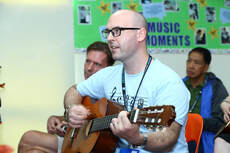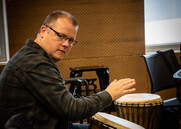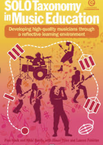|
All the news from Musical Futures International
|
 Christopher Hoddinott is a Music Teacher at GEMS World Academy in Singapore. Since attending our first Intensive Musical Futures Workshop in Malaysia in 2016 and returning for a 'recharge' in Singapore in 2019, he has explored various Musical Futures International Learning Models including Just Play, Non Formal Teaching and Informal Learning. Here he shares some of the positive outcomes that have been emerging as a result. At our school, we have found that making music education relevant to students themselves means that they demonstrate a deeper understanding of music and we see a motivation for learning that is intrinsic. We start by offering musical activities that students enjoy, ranging from Karaoke, Rock Bands and Electronic Music Production and then lead them into ensembles and musical performances. Our practice rooms have gone from empty at lunchtime and after school to full as students feel it is a welcoming and productive environment. Allowing students the opportunities to develop in the classroom means they want to get more involved in music outside of the classroom. Students now want to create and perform as they have developed a love of music and therefore wish to inquire and improve themselves. Students are more engaged as they have been given the freedom to be creative and are trusted to think outside of the box in order to be innovative. So how did we get here? Just PlayMusical Futures International: Just Play is designed to build holistic musical skills and an understanding of how to play as a whole class band. It comes with a suite of resources that support teachers with delivering whole class music activities with students of any age. Getting students performing and being interactive is and important step in their music education. Once students are enjoying playing a musical instrument, the technical and theoretical aspects often follow. Once they can play something, students are more inquisitive to find out more about how to improve and what else is involved in music as a subject at school. Learning a musical instrument ensures that all students can access an inclusive and engaging music education. Just Play allows all students to play and perform, whether it is the ukulele, guitar, bass, piano or the voice. Playing music inside and outside of the classroom gives students a platform to be creative in music. There are opportunities to develop transferable skills such as creative thinking, collaboration and listening as well as learning instrumental skills and how and why and music works. The music classroom, therefore, becomes an inclusive environment, highly skilled musicians, as well as beginners are able to thrive as there is an opportunity to play independently and collaboratively, to set personal goals, and find themselves through playing a musical instrument. Performing and CreatingNon Formal Teaching is a whole class approach to large group music making, improvising and composing. Grounded in non-formal teaching pedagogy inspired by the practices of community musicians, musical ideas originate from within the group with the teacher as musical leader helping participants to shape and develop the music as it evolves With each unit of work, students are either demonstrating their skills and knowledge development through performing or creating and are often doing both during every lesson. When creating music through classroom workshopping, students are given the autonomy to build composing and improvising from music that they are interested in and enjoy, and the process allows for exploring styles that engage the student from the start. The theory of creating music, such as understanding chord progressions, harmony, melody, rhythm and structure are explored and applied through the creation of a piece of music. Therefore, students see the relevance and the immediate practical implications of music theory. They are therefore better able to understand and relate to music theory more effectively. They are also able to see the relevance of how different aspects of musical theory can be applied to create different moods and outcomes in the music. Students create more interesting pieces of music as a result as they have been able to explore and problem solve in a way that also allows them to expresses themselves. Some students expand on what is done in the classroom and start to make their own musical legacy by writing music that they publish by themselves, developed from the skills explored and supported in the classroom. A great example from recent classroom practice at my school involved supporting students to write a song about a social justice issue that they cared about. They researched songs that covered particular issues, discussed and asked questions about why and how the music was created and if it was effective in portraying their message. Students were then given the challenge of writing and recording songs, building their own identity and connections in the world as global citizens - key outcomes for our school and the curriculum that we follow. In order to successfully make the song, students had to learn about the key, scale, chord progression, melody, bass, rhythm, harmony and structure. They also learnt recording skills and how to produce their song. Some students were so proud of their creations they performed their songs in class to others. Informal LearningInformal Learning is a model of self-directed learning that aims to enhance student motivation, enjoyment and skill-acquisition in music lessons by tapping into the real-life learning practices of popular musicians Informal learning is one of the approaches we use to create musical performances. We have found that it makes the learning more authentic and develops skills that are important in learning music. Students spend time developing listening, collaboration, creative and practical skills when performing music. Informal Learning challenges students to choose a piece of music in their friendship groups and they are encouraged to learn the song by listening to the music, rather than relying on notation, chord charts or tabs. Students immediately rose to the challenge. Working with their friendship groups meant that they could motivate and encourage each other. They could also be more honest and critical about the ideas and choices that they made. They also helped each other in figuring out parts of the music and natural leaders emerged from the groups. Students developed their listening skills as they had to dissect the music into its harmonic parts, such as melody, rhythm and the structure, and then piece it all together for their own creation. Informal learning has proved to be a dynamic and practical way to develop listening skills that created a deeper understanding of what is happening in the music. Rather than listening to and identifying sections of music, students are analysing and inquiring about the music in a deeper way. They are also more responsive to enjoying, performing, creating and interacting with the music. Ultimately, we have found that informal learning builds confidence and they are excited to perform to their peers. Students are keen to develop themselves and progress, and the demand comes to provide more opportunities for students to perform at all levels as a result. ConclusionMusic education should be active and engaging for students, but also inclusive, so that all students are developing themselves and always learning. It is important that the learning is authentic and that teaching nurtures valuable creative thinking and collaboration skills as well as core instrumental skills. Learning should be active and practical, and at the core of music education is the right balance of building instrumental skills and creating and performing music.
0 Comments
We have just returned from a wonderful 2 days working with teachers from across Europe, hosted in the fantastic music department at Ecolint International School of Geneva. As well as exploring the core Musical Futures Learning models of Informal Learning and Non-Formal Teaching, we also had great fun trying out the multitude of Musical Futures International resources available free of charge to all who attended and we spent some time considering now we might apply those to different teaching scenarios in classrooms. A stand out moment was our day 2 rap warm-up where we had raps in Welsh, English, Finnish, Estonian, French, Lebanese and Hungarian! We were also joined by Alan Cameron who led an informative session using Soundtrap and all delegates were given a free 3 month trial of Soundtrap Edu to use in their schools. Huge thanks to everyone who came along and to John Aram and the staff and students at Ecolint for being such welcoming hosts! Our next Musical Futures Europe workshop takes place at St George's British International School in Rome in January 2020. Find out more... We are always happy to hear from schools interested in hosting a workshop. You can find out more about what's involved and how to get in touch by clicking -> *here*  Luke Peak is Head of Music at Chaffey Secondary College, Mildura and a Musical Futures International Champion. He has been exploring using the SOLO Taxonomy in the Musical Futures classroom and in this article shares some of the ideas and outcomes that have developed across this year. Musical Futures at Chaffey Secondary CollegeChaffey Secondary College has been a Musical Futures Champion School since 2014. The school is located in Mildura, a regional city in north-west Victoria approximately 6 hours’ drive from Melbourne. The classroom music program has grown considerably since I started at the college back in 2011. As a graduate teacher I began working with the Musical Futures approach almost immediately using the Informal Learning model. Students responded positively to learning music in a self-directed and independent way as I encouraged them to work in friendship groups, learning songs of their choice and playing instruments of their choice. As Musical Futures evolved over these years, I was able to incorporate Just Play & Non-Formal Teaching into my Year 7 & 8 classes. In this setting students build functional music skills on a range of instruments through whole class music making using a variety of resources and play-a-longs. Introducing song charts enables a large group of students to begin moving away from the play-a-longs as they develop their musical proficiency and exercise more student voice in song selection and arrangements. As students move into Year 9 and 10 electives, they begin to display more independence as they form friendship groups, choose the music to play and direct their own learning. This is where my role as a teacher shifts from being the musical leader to more of a musical model and resource. Why SOLO Taxonomy?An ongoing challenge has been the formalised tracking of musical progress in a Musical Futures classroom and having reliable formative assessment tools that allow for self-reflection and promote metacognition. As students’ progress through the Musical Futures program they are essentially moving from surface knowledge to deep learning which can be observed as students display greater independence and proficiency over time. As a school we have developed a new instructional model. At its foundation is the implementation of the Visible Learning framework and the use of SOLO taxonomy across all our key learning areas. For those who are not familiar with SOLO taxonomy, it stands for the Structure of Observed Learning Outcomes (SOLO). As a school we have been using SOLO to create differentiated success criteria for our lessons in order to support our learners in moving from surface knowledge to deep learning. Throughout this year I have begun to develop a deeper understanding of how to use the SOLO taxonomy to plan, monitor and evaluate the effect of my teaching on student learning. About SOLO TaxonomyWhen using the SOLO taxonomy in your classroom an important distinction to make is the difference between declarative and functioning knowledge. Declarative knowledge involves knowing about (content based), whereas functioning knowledge is knowing how to (skills/performance based). For the majority of my music classes, the focus is on functioning knowledge. This means that most of my Learning Intentions will start with: To be able to….. Developing SOLO based differentiated success criteria for classes that are dedicated to building musical skills can be used as a way of tracking individual progress over time. SOLO Taxonomy use five hierarchical levels of learning outcome.
 In Term 3 this year I came across the newly published book: Solo Taxonomy in Music Education (Pam Hook & Nikki Booth, with Alison Price & Lauren Fobister) This book has been a great resource for me in developing formative self-assessment rubrics to enable students to identify the progression of their learning outcomes whilst providing me with a reliable tool to track musical progress over time. SOLO rubrics for Musical FuturesThe following SOLO rubrics have been adapted directly from the book mentioned above. What I have found of particular value is how these formative assessment tools compliment and align directly to existing Musical Futures lessons. They provide a clear description of the varying levels of learning outcome and help to promote self-regulation as they show students the progression toward becoming more independent in relation to the learning intention. OutcomesSharing the SOLO taxonomy with students is helping them make more sense of their learning. In regard to the examples provided I would project the self-assessment rubric at the beginning of a lesson and discuss with the class the different levels of SOLO outcomes that a student may experience by the end of the lesson or unit. As a point of reflection at the end of the lesson I would use the self-assessment rubric so they can develop a better awareness of their individual progress.
As I’ve only introduced these SOLO formative assessment tools this term, my aim is to familiarise my students with the taxonomy so that I’m helping them to understand how it works and how it can be applied to their learning in my lessons. Using SOLO to elicit feedback and develop self-regulated learners is certainly something that I feel aligns with the Musical Futures approach. As a school we have done a lot of work and professional learning around effective feedback this year. Feedback should answer the following 3 questions for both the students and teachers:
SOLO then becomes the measure of quality of the outcome of a lesson. As students become more familiar with this process of reflection their self-regulation develops. This means that they begin to become less reliant on the feedback from the teacher as they assess their own learning progress. Using the SOLO taxonomy as a Musical Futures teacher has brought me greater clarity around making the individual learning outcomes more visible for myself and my students. I have spent a lot of time considering the engagement and authenticity of my lessons which is why Musical Futures continues to resonate strongly with me and my students. The SOLO taxonomy model clearly shows how a learner’s performance changes in this environment from someone who is dependent and reliant to one who is independent and self-reliant. |
AuthorWrite something about yourself. No need to be fancy, just an overview. Archives
August 2023
Categories |
